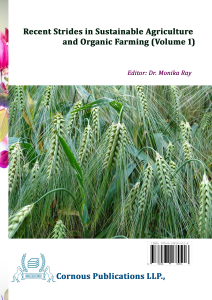The chapter explores into the fundamental concepts that define organic agriculture. Organic farming is driven by health, ecological and ethical values aimed at promoting sustainability, biodiversity, and soil health. Essential to organic farming are the principles of natural input use, crop rotation, and composting, which aim to reduce dependance on synthetic chemicals while enhancing soil fertility. The chapter highlights how organic farming practices prioritize ecosystem equilibrium, nurturing the relationship between plants, animals, and the environment. Key principles discussed include soil management through organic matter enrichment, pest control through biological methods and water conservation. Moreover, the importance of genetic diversity and the use of locally adapted seeds are underscored to support flexibility against climate change. The chapter also emphasizes the ethical considerations in organic farming, focusing on social justice, animal welfare and fair labor practices. With the growing global demand for sustainable food systems, the chapter delivers understandings into how organic farming aligns with environmental stewardship and consumer health; while addressing challenges such as yield efficiency and market accessibility. The general approach in organic farming contributes to long-term agricultural sustainability and food security.
Water is one of the critical agricultural resources for crop growth, crop yield and livestock health. Suitable water management methods help farmers to conserve water, improve irrigation efficiency and reduces waste. Organic farmers highly depend on rainfall or ground water resource to water their crops as irrigation source. The available water resources for agriculture should be utilized very cautiously in the farm. In organic agriculture water in terms of soil moisture play major roles in plant nutrition. Growth and multiplication of microbes much rely on adequate soil moisture which could be achievable through efficient water management technologies. Micro irrigation has potential to apply bio inputs viz., panchagavya, amirthakaraisal, jeevamirtham etc., through irrigation which increase the microbial activity in soil and improve soil fertility eventually growth and yield of the crop under organic farming.
Crop rotation and diversification are pivotal practices in organic agriculture that enhance soil health, reduce pest and disease pressures, and promote biodiversity. This chapter delves into the principles and benefits of these practices, offering a comprehensive overview of their theoretical underpinnings, practical applications, and empirical evidence. Crop rotation involves systematically varying crops in a sequence to improve soil fertility and manage pests, while diversification encompasses growing multiple types of crops simultaneously or in rotation to bolster farm resilience. This chapter provides a detailed examination of these practices, including their impact on soil health, pest management, and economic stability, supported by tables and images illustrating their benefits and applications.
 ISBN : 978-81-981855-1-8
ISBN : 978-81-981855-1-8